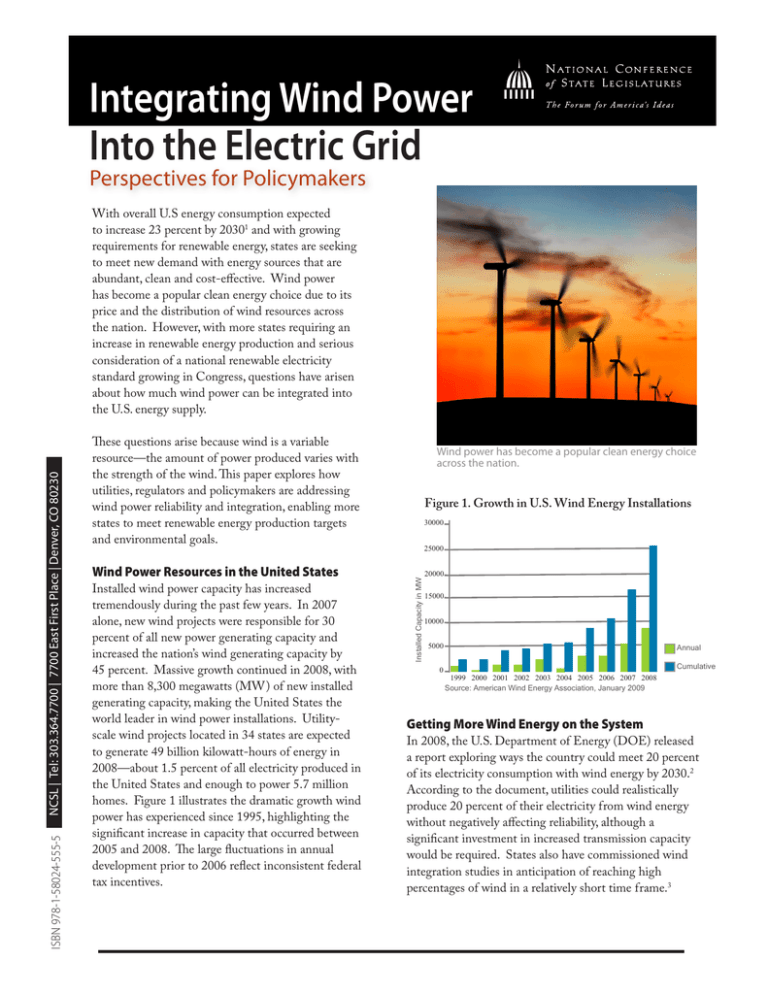
Integrating Wind Power
Into the Electric Grid
Perspectives for Policymakers
ISBN 978-1-58024-555-5
These questions arise because wind is a variable
resource—the amount of power produced varies with
the strength of the wind. This paper explores how
utilities, regulators and policymakers are addressing
wind power reliability and integration, enabling more
states to meet renewable energy production targets
and environmental goals.
Wind Power Resources in the United States
Installed wind power capacity has increased
tremendously during the past few years. In 2007
alone, new wind projects were responsible for 30
percent of all new power generating capacity and
increased the nation’s wind generating capacity by
45 percent. Massive growth continued in 2008, with
more than 8,300 megawatts (MW) of new installed
generating capacity, making the United States the
world leader in wind power installations. Utilityscale wind projects located in 34 states are expected
to generate 49 billion kilowatt-hours of energy in
2008—about 1.5 percent of all electricity produced in
the United States and enough to power 5.7 million
homes. Figure 1 illustrates the dramatic growth wind
power has experienced since 1995, highlighting the
significant increase in capacity that occurred between
2005 and 2008. The large fluctuations in annual
development prior to 2006 reflect inconsistent federal
tax incentives.
Wind power has become a popular clean energy choice
across the nation.
Figure 1. Growth in U.S. Wind Energy Installations
30000
25000
Installed Capacity in MW
NCSL | Tel: 303.364.7700 | 7700 East First Place | Denver, CO 80230
With overall U.S energy consumption expected
to increase 23 percent by 20301 and with growing
requirements for renewable energy, states are seeking
to meet new demand with energy sources that are
abundant, clean and cost-effective. Wind power
has become a popular clean energy choice due to its
price and the distribution of wind resources across
the nation. However, with more states requiring an
increase in renewable energy production and serious
consideration of a national renewable electricity
standard growing in Congress, questions have arisen
about how much wind power can be integrated into
the U.S. energy supply.
20000
15000
10000
5000
0
Annual
Cumulative
1999 2000 2001 2002 2003 2004 2005 2006 2007 2008
Source: American Wind Energy Association, January 2009
Getting More Wind Energy on the System
In 2008, the U.S. Department of Energy (DOE) released
a report exploring ways the country could meet 20 percent
of its electricity consumption with wind energy by 2030.2
According to the document, utilities could realistically
produce 20 percent of their electricity from wind energy
without negatively affecting reliability, although a
significant investment in increased transmission capacity
would be required. States also have commissioned wind
integration studies in anticipation of reaching high
percentages of wind in a relatively short time frame.3
In Iowa, MidAmerican Energy already has exceeded
a 10 percent penetration level.4 In Minnesota,
Xcel Energy is approaching 10 percent wind as a
percentage of peak load and is on track to reach 25
percent by 2020. A comprehensive wind integration
study, conducted at the request of the Minnesota
Legislature, found that the state could integrate 25
percent wind energy into its energy portfolio with
little difficulty. The integration cost was estimated
at less than a half-cent per kilowatt-hour (kWh) of
wind energy. Minnesota performed this study to
determine the cost and infrastructure impacts of its
25 percent renewable electricity standard.
Other studies have produced similar cost estimates
for integrating up to 30 percent wind energy.5 Wind
energy often displaces higher-cost energy from other
sources. Although there is an incremental cost to
integrate wind energy, adding it to the mix of power
sources can reduce average electricity costs and
provide savings to electricity customers.
Coordinating Energy Supply and Demand
To understand how wind power can be added to
the power grid, it is important to recognize how
system operators balance supply and demand. The
demand for electricity (referred to as “load”) can vary
widely based on weather—heating and cooling loads
dominate utility peak demand. The time of day also
influences load, since energy use tends to peak during
the daytime when business and industrial needs are
highest. Load also fluctuates with the time of year
as seasonal changes influence heating, cooling and
lighting needs. Although load forecasting is good,
loads are somewhat unpredictable. Production
also can be unpredictable since power plants and
transmission lines can fail unexpectedly or must be
taken out of service for maintenance. Wind plants
create additional variation because they generate
electricity based on wind speed, which changes over
time. System operators are responsible for balancing
varying demand and supply. They can treat a
reduction in wind energy the same as they would an
increase in energy demand.
To account for the variations in electricity demand
and production, system operators use balancing
techniques that focus on three basic time frames:
regulation, load following and unit commitment.
2
Regulation – Fast, unpredictable variations in load
occur in short (seconds to minutes) time frames,
so energy generation must be ready for increases or
decreases to meet the changes. Since variations in
wind energy generally take place over longer times,
wind power needs only minimal regulation. An
automatic generation control system monitors load
and generation and automatically balances the two
by sending signals to power plants to increase or
decrease their output. The cost of regulation related
to wind energy variability is fairly low—less than 0.1
cent per kWh of wind energy.6
Load Following – Energy demand and wind energy
output vary more dramatically over time frames
that extend from 10 minutes to several hours. The
longer time frames cover the variation from low
electricity consumption in the middle of the night to
high consumption during the day. To balance energy
production and consumption during this longer
time frame, system operators deploy various types of
generation to meet energy demand at the lowest cost,
as shown in Figure 2.
Figure 2. Typical Daily Load Shape
Source: U.S Department of Energy (DOE), 20 Percent Wind
Energy by 2030, (2008)
Unit Commitment – Some generators (including
coal-fired power plants) require longer-term planning
because they need anywhere from hours to days of
preparation before they can generate power. System
operators select which generators will be needed for
each day’s operation through the unit commitment
process. They strive to ensure that adequate
generation is available to reliably meet load at lowest
cost.
NCSL | Tel: 303.364.7700 | 7700 East First Place | Denver, CO 80230
System operators are responsible for balancing the
continually changing demand and supply despite
daily cycles and minute-to-minute changes. To
ensure that adequate generation is available to meet
electricity demand, system operators typically ensure
availability of reserve energy. Reserves that are online and available to respond within 10 minutes are
known as spinning reserves. Reserves with longer
response times are referred to as non-spinning
reserves.
To adapt to changes, the grid requires reserve capacity
to manage variability in load and wind energy output.
Actual experience with wind power integration shows
that dedicated back-up generation for wind power
is unnecessary; instead, system operators can simply
employ existing spinning and non-spinning reserves.
Also, wind forecasting is an essential tool to help
system operators manage the uncertainty associated
with relying upon a significant amount of wind
energy.
Just as the combined random actions of millions
of consumers turning appliances on and off create
a relatively stable demand for electricity, variations
in the outputs of wind turbines spread over a large
area result in consistent power generation over time
periods of 30 minutes or less. This is one of the main
reasons that spreading wind projects over larger
regions significantly reduces the cost of integration.
Costs of Wind Integration
The size of the electricity market and the load
balancing area play a significant role in the ease and
cost of wind integration. Larger markets have more
resources to cost effectively balance energy demand
and supply, which reduces the overall variability in the
system. Large regional energy markets also offer a
better variety of financial mechanisms that can reduce
the cost of wind integration.7
The mix of energy generation resources in an
electricity market also plays an important role in
determining the cost of integrating wind power.
Research conducted in California and elsewhere
found markets that incorporate large amounts of
hydroelectric and natural gas generation—both
of which can be easily adjusted to meet changing
demand—tend to have lower integration costs than
systems that rely on more inflexible generation, such
as coal or nuclear power. California found that the
cost of integrating wind energy is essentially zero, in
part due to the large number of flexible generators
in the state and the large balancing area. Other
large market areas have found integration costs to
be less than 0.5 cents per kWh when wind energy
contributes up to 25 percent of energy generation.
Demand response policies, which help large
electricity users reduce their non-essential electricity
use on command, can also be a very cost effective way
to accommodate the variability of wind power.
Too much wind power sometimes is a concern. This
issue can arise in a system that supplies substantial
wind energy output during periods of low demand—
generally at night when winds can be high and
most demand is met by large, inflexible coal-fired
or nuclear plants. Because it is difficult and costly
to reduce production in such plants, a large influx
of wind energy can cause operational problems
and increase costs. Larger power markets, forced
curtailment of wind plant output, and addition of
new loads that can make use of excess nighttime
energy can help avoid this problem. One nighttime
load that may become prominent in the near future is
charging electric and hybrid vehicles.
Perhaps most important are the region’s wholesale
market structure and scheduling practices. Regions
with sub-hourly markets or sub-hourly scheduling
(the large ISOs, for example) have greatly reduced
wind integration costs because they can more quickly
access the response capabilities of the conventional
generators. Regions that only allow hourly scheduling
generally have higher integration costs.
NCSL | Tel: 303.364.7700 | 7700 East First Place | Denver, CO 80230
3
Trends in Wind Integration
A decade ago, concern was expressed that the
variability and uncertainty of wind would seriously
impair the reliability and stability of the electric
power system. Today, after considerable practical
experience with wind power, power system engineers
acknowledge that—even with substantial wind energy
contributions—the lights will stay on. The major
questions now about wind power growth are “What
are the costs associated with its integration into the
system, and how can these costs be minimized?”
Integrating wind power into the electricity grid will
require changes to the business-as-usual operation
of the electric power system, however, many of these
changes are already being implemented. Although
studies show the potential for modest integration
costs due to increased wind power generation, the
cost-benefit studies conducted to date find that wind
penetration levels as high as 30 percent are likely
to have little effect on consumers.8 State policies,
electricity market structure, the size of the balancing
area, and the diversity of energy resources influence
the ease and cost of wind integration. In some
cases, consumer rates will actually decrease because
incremental integration costs can be more than offset
by savings from reduced consumption of fuels such as
natural gas.
The challenge of transforming how the United States
produces and distributes electricity is being met headon by states nationwide. They are using innovative
techniques to improve the quality, reliability and
stability of the electric grid and simultaneously are
increasing the amount of domestically produced clean
energy. Although the effort has just begun, states
are successfully creating and implementing plans
to address the most significant challenges to wind
integration.
Notes
1. U.S. Department of Energy, Annual Energy
Outlook 2008 (Early Release) (Washington, D.C.:
U.S. DOE, DATE); www.eia.doe.gov/oiaf/aeo/
electricity.html.
2. U.S. Department of Energy, 20% Wind Energy
by 2030: Increasing Wind Energy’s Contribution to
U.S. Electricity Supply (Washington D.C.: U.S.
DOE, 2008); www1.eere.energy.gov/windandhydro/
wind_2030.html.
3. J. Charles Smith et al., “Utility Wind
Integration and Operating Impact State of the Art,”
IEEE Transactions on Power Systems 22, no. 3 (August
2007).
4. U.S. Department of Energy, 20% Wind Energy
by 2030: Increasing Wind Energy’s Contribution to U.S.
Electricity Supply, 77.
5. Most of these studies can be found at the
Utility Wind Integration Group website: www.uwig.
org.
6. M. Milligan, H. Shiu, B. Kirby, and K. Jackson,
Multi-Year Analysis of Renewable Energy Impacts
in California: Results from the Renewable Portfolio
Standards Integration Cost Analysis (NREL Report No.
CP-500-40058) (Golden, Colo.: NREL, 2006).
7. U.S. Department of Energy, 20% Wind Energy
by 2030: Increasing Wind Energy’s Contribution to U.S.
Electricity Supply, 92.
8. Richard J. Piwko et al., “Appendix B,
Impact of Intermittent Generation on Operation of
California Power Grid” (CEC-500-2007-081-APB)
(Schenectady, N.Y.: GE Energy Consulting, July
2007).
Resources
National Conference of State Legislatures
Renewable Energy WebPage
www.ncsl.org/programs/energy/RenEnerpage.htm
State Siting and Permitting of Wind Energy
Facilities, 2006
www.nationalwind.org/publications/siting/Siting_
Factsheets.pdf
Utility Wind Integration and Operating Impact
State of the Art, 2007
www.nrel.gov/docs/fy07osti/41329.pdf
Utility Wind Integration Group – Wind
Integration Library
www.uwig.org/opimpactsdocs.html
© 2009 by the National Conference of State Legislatures. All rights reserved. Produced in cooperation with the National Wind Coordinating Collaborative.
4
NCSL | Tel: 303.364.7700 | 7700 East First Place | Denver, CO 80230



